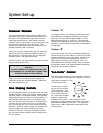
Page 7
STATEMENT Set-up Manual
Rules of ThumbRules of Thumb
Rules of ThumbRules of Thumb
Rules of Thumb
Hard vs. Soft Surfaces. If one surface of your room
(wall, floor, ceiling) is hard, a good rule of thumb
suggests to try to have the opposing surface soft. So,
if you have a hard wall of glass or paneling on one
side of the room, it is best to have drapery or wall
hangings on the opposing wall. If you have a hard
ceiling, it generally is a good idea to have a soft floor
of carpeting or area rugs. Large, soft furniture also
counts to help damp a highly reflective room.
This rule suggests that a little reflection is good. As a
matter of fact, some rooms can be so “over damped”
with carpeting, drapes and sound absorbers that the
music system can sound dull and lifeless. On the
other hand, rooms can be so hard that the system
can sound like a gymnasium with too much reflec-
tion and brightness. The point is that balance is the
optimum environment.
Break-up Objects. Objects with complex shapes, such
as bookshelves, cabinetry, and multiple shaped
walls can help to break up those sonic gremlins and
diffuse any dominant frequencies.
Solid Coupling. Your loudspeaker system generates
frequency vibrations or waves into the room. This is
how it creates sound. Those vibrations will vary from
20 per second to 20,000 per second. If your speaker
system is not securely planted on the floor or solid
surface, it can shake as it produces sound, and
consequently the sound can be compromised. If
your speaker is setting on the carpet and only foot
gliders are used, the bass can be ill defined and
even boomy. Additionally, the imaging can be poorly
located and diffuse if the system is not on solid footing.
Bipolar Speakers and Your RoomBipolar Speakers and Your Room
Bipolar Speakers and Your RoomBipolar Speakers and Your Room
Bipolar Speakers and Your Room
Martin-Logan electrostatic loudspeakers are known as
bipolar radiators. This means that they produce sound
from both their fronts and their backs. Consequently,
musical information is reflected by the wall behind them
and may arrive either in or out of step with the information
produced by the front of the speaker.
The low frequencies can either be enhanced or nulled by
the position from the back wall. Your Statements's have
been designed to be placed 3 feet from the back wall to
obtain the best results, however your room may see
things differently. So, listening to the difference of the
bass response as a result of the changes in distance
from the back wall can allow you to get the best combina-
tion of depth of bass and tonal balance.
The mid-range and high frequencies can also be
affected, but in a different way. The timing of the first wave
as it is first radiated to your ears and then the reflected
information as it arrives at your ears later in time, can
result in confusion of the precious timing information that
carries the clues to imaging and, consequently result in
blurred imaging and excessive brightness. Soft walls,
curtains, wall hangings, or sound dampeners (your
dealer can give you good information here) can be
effective if these negative conditions occur.










